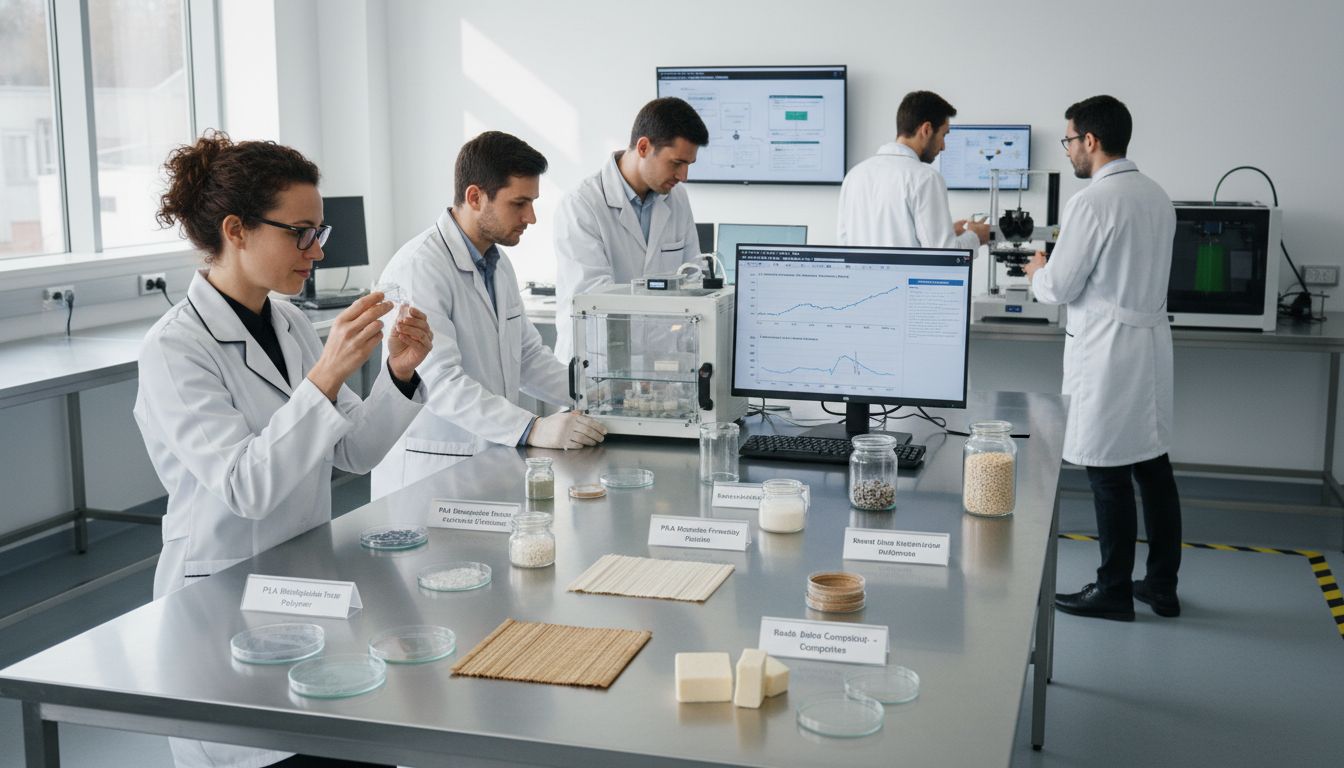Your Cart is Empty
Free Standard Shipping for Contiguous U.S. Orders!
Free Standard Shipping for Contiguous U.S. Orders!
Catalog

What Is Biodegradable? Complete Guide for 2025
November 06, 2025 6 min read
Every year, the world produces over 300 million tons of plastic waste, with only a fraction ever breaking down naturally. This growing mountain of garbage poses a threat to our environment and health, making it urgent to find better solutions. Biodegradable materials offer a promising answer by returning safely to the earth instead of lasting for centuries. Learn what makes these materials different and why understanding their core concepts helps shape a more sustainable future.
Table of Contents
- Defining Biodegradable And Core Concepts
- Types Of Biodegradable Materials Explained
- How The Biodegradation Process Works
- Common Uses And Real-World Applications
- Biodegradable Vs. Compostable: Key Differences
Key Takeaways
| Point | Details |
|---|---|
| Biodegradable Materials | Biodegradable materials decompose naturally through microbial activity, significantly reducing long-term waste impact. |
| Types | Common types include bioplastics, natural fiber composites, and organic material blends, each contributing uniquely to sustainability. |
| Biodegradation Processes | Biodegradation occurs via aerobic and anaerobic pathways, with varying rates influenced by environmental conditions. |
| Differences from Compostable | Biodegradable materials break down over time without specific conditions, while compostable materials require defined composting conditions to decompose fully and safely. |
Defining Biodegradable and Core Concepts
Biodegradable materials represent an innovative solution to environmental waste management, offering a sustainable pathway for reducing long-term ecological impact. According to Britannica, biodegradability refers to a material’s remarkable ability to be completely broken down by living organisms like bacteria and fungi into natural substances such as water, carbon dioxide, and biomass.
At its core, biodegradation is a complex natural process where microorganisms systematically decompose organic materials. Library Research highlights that these materials play a crucial role in sustainable manufacturing by providing environmentally friendly alternatives that minimize long-term waste accumulation.
Key characteristics of biodegradable materials include:
- Natural decomposition through microbial activity
- Ability to break down without leaving toxic residues
- Conversion into harmless natural elements
- Significantly shorter environmental persistence compared to synthetic materials
Understanding biodegradation requires recognizing the intricate biological mechanisms that transform complex organic compounds into simpler molecular structures. This process depends on several critical factors including temperature, moisture, oxygen availability, and the specific microbial ecosystem present in a given environment. Why Choose Bamboo Home Products: Sustainable Living Explained provides additional insights into sustainable material selection and their environmental impact.
Types of Biodegradable Materials Explained
Biodegradable materials represent a diverse and innovative category of substances designed to minimize environmental impact through natural decomposition. Winsome Publishing highlights several key types of biodegradable plastics, including Polylactic Acid (PLA), Polyhydroxyalkanoates (PHAs), starch blends, Polybutylene Succinate (PBS), and cellulose-based plastics. Each of these materials offers unique properties that contribute to reducing environmental pollution.
According to Library Research, biodegradable materials extend far beyond traditional plastics, encompassing a wide range of sustainable alternatives. These include:
- Natural fiber composites
- Bioplastics
- Organic material blends
- Plant-based polymers

The most prominent types of biodegradable materials can be categorized into several key groups:
- Bioplastics
- Polylactic Acid (PLA): Derived from renewable resources like corn starch
- Polyhydroxyalkanoates (PHAs): Produced by microorganisms through bacterial fermentation
- Polybutylene Succinate (PBS): A synthetic biodegradable polymer
- Natural Fiber Materials
- Cotton
- Hemp
- Bamboo fibers
- Jute
For eco-conscious consumers looking to understand sustainable material choices, Understanding the Reasons to Choose Bamboo for Sustainability provides additional context on selecting environmentally friendly materials that support sustainable living practices.
How the Biodegradation Process Works
Britannica explains that biodegradation is a complex natural process where microorganisms systematically break down materials into simpler substances. This intricate biological mechanism transforms organic compounds through a series of chemical reactions, ultimately converting complex materials into basic elements like water, carbon dioxide, and biomass.
According to Library Research, biodegradation can occur through two primary metabolic pathways:
- Aerobic Biodegradation
- Occurs in oxygen-rich environments
- Produces carbon dioxide, water, and biomass
- Typically faster and more efficient
- Common in surface-level decomposition
- Anaerobic Biodegradation
- Occurs in oxygen-depleted environments
- Yields methane as a primary byproduct
- Slower decomposition process
- Typical in deep soil or landfill conditions
Key factors influencing the biodegradation rate include:
- Material composition
- Environmental temperature
- Moisture levels
- Presence of specific microorganisms
- Oxygen availability
For those interested in sustainable material choices, Understanding the Reasons to Choose Bamboo for Sustainability offers additional insights into environmentally friendly materials and their natural decomposition characteristics.
Common Uses and Real-World Applications
Winsome Publishing reveals the expansive potential of biodegradable materials across multiple industries. Biodegradable plastics have emerged as a revolutionary solution, finding critical applications in packaging, disposable cutlery, and even sophisticated medical implants. These innovative materials are transforming how we approach environmental sustainability by enabling natural decomposition and reducing long-term waste accumulation.
According to Library Research, biodegradable materials are strategically incorporated into various production processes to minimize environmental impact. The most prominent real-world applications include:
- Packaging Solutions
- Food packaging
- Shipping containers
- Agricultural film wraps
- Protective packaging materials
- Consumer Products
- Disposable cutlery
- Single-use food service items
- Personal care product containers
- Compostable shopping bags
- Medical and Healthcare
- Surgical implants
- Wound dressings
- Pharmaceutical packaging
- Temporary medical devices
- Agricultural Applications
- Seed coatings
- Mulch films
- Fertilizer carriers
- Plant growth containers
For eco-conscious consumers seeking sustainable alternatives, Understanding the Reasons to Choose Bamboo for Sustainability provides additional context on selecting environmentally responsible materials that support green living practices.
Biodegradable vs. Compostable: Key Differences
Britannica provides crucial insights into the nuanced differences between biodegradable and compostable materials. While these terms are often used interchangeably, they represent distinct processes of environmental decomposition. The key distinction lies in the specificity of breakdown conditions and the ultimate environmental impact.
According to Library Research, the fundamental differences can be understood through several critical parameters:
Biodegradable Materials
- Break down naturally over time
- Decompose through biological processes
- No specific environmental conditions required
- May take months to years to fully decompose
- Can potentially leave trace chemical residues
Compostable Materials
- Require specific composting conditions
- Break down completely into nutrient-rich soil
- Must decompose within a defined timeframe (typically 90-180 days)
- Leave no toxic residue
- Must meet strict industrial composting standards
Key Comparison Points:
- Decomposition Speed
- Environmental Impact
- Breakdown Conditions
- Resulting Byproducts
Here’s a comparison of biodegradable and compostable materials:

| Key Aspect | Biodegradable Materials | Compostable Materials |
|---|---|---|
| Breakdown Process | Natural decomposition by organisms | Requires controlled composting |
| Timeframe | Months to years | 90-180 days (industrial compost) |
| Environmental Conditions | No specific requirements | Specific temperature moisture needed |
| Final Byproducts | Water, CO₂, biomass possible residues |
Nutrient-rich soil no toxic residue |
| Standards | None universally required | Must meet composting certifications |
For those interested in sustainable home solutions, Understanding Why Choose Bamboo Over Plastic for Your Home offers additional insights into making environmentally conscious material choices.
Choose Sustainable Solutions with Bamboo for a Greener Tomorrow
The challenge many face after learning about biodegradable materials is finding real products that align with eco-friendly goals without compromising style or functionality. You want items that naturally break down over time, reduce waste, and avoid harmful residues. This article highlights the importance of choosing materials that support a cleaner environment through natural biodegradation processes and quicker decomposition.
Cozee Bay offers a unique answer to this challenge by providing handcrafted bamboo products designed with sustainability in mind. Bamboo is a fast-growing natural fiber that biodegrades much faster than synthetic materials. Our premium bamboo paper towel dispensers and home organizers bring elegance and environmental responsibility into your living or commercial space. These products are perfect for eco-conscious homes, schools, restaurants, and offices that value both durability and green living.
Enhance your commitment to sustainability now by discovering how easy it is to replace plastic and synthetic materials with stylish bamboo solutions at Cozee Bay.

Explore our full range of eco-friendly bamboo products including paper towel dispensers, food bag organizers, and more. Make a positive impact for today and future generations by switching to natural, biodegradable materials crafted for real use. Visit us today at Cozee Bay and join the movement to live greener with smart, sustainable choices.
Frequently Asked Questions
What does biodegradable mean?
Biodegradable refers to a material’s ability to decompose through natural processes, typically involving microorganisms like bacteria and fungi, into harmless substances such as water, carbon dioxide, and biomass.
What are the different types of biodegradable materials?
Common types of biodegradable materials include bioplastics such as Polylactic Acid (PLA), Polyhydroxyalkanoates (PHAs), natural fiber composites, and organic material blends, which provide environmentally friendly alternatives to synthetic materials.
How does the biodegradation process work?
Biodegradation is a natural process where microorganisms break down complex organic materials into simpler substances. It occurs through aerobic conditions (with oxygen) producing carbon dioxide and biomass, or anaerobic conditions (without oxygen) producing methane.
What is the difference between biodegradable and compostable materials?
Biodegradable materials decompose naturally over time and can take months to years, potentially leaving residues. Compostable materials break down under specific conditions into nutrient-rich soil within a set timeframe (typically 90-180 days) and leave no toxic residues.
Recommended
- Cozee Bay - 10 Essential Sustainable Living Tips for Every Homeowner
- Cozee Bay - Why Choose Bamboo Home Products: Sustainable Living Explained
- Cozee Bay - Understanding the Environmental Benefits of Bamboo
- Cozee Bay - Understanding Why Choose Bamboo Over Plastic for Your Home
- Understanding Biodegradable Wheat Straw for Sustainable Choices – The Ocean Straw
- Verschil Afbreekbaar & Recyclebaar: Complete Gids – Earth Saver Straws
Leave a comment
Comments will be approved before showing up.
Subscribe
Sign up to get the latest on sales, new releases and more …

